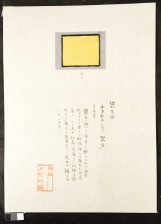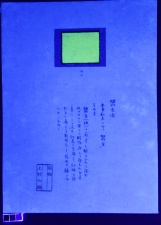Difference between revisions of "Ukon (Turmeric) - center (20 C)"
Jump to navigation
Jump to search
(username removed) |
m (MDerrick moved page Ukon - center (20 C) to Ukon (Turmeric) - center (20 C) without leaving a redirect) |
||
| (One intermediate revision by one other user not shown) | |||
| Line 5: | Line 5: | ||
| 20 | | 20 | ||
|- | |- | ||
| − | ! scope="row"| | + | ! scope="row"|Uemura number / title |
| − | | | + | | ; "Haze-some 25" |
|- | |- | ||
! scope="row"|Folder location | ! scope="row"|Folder location | ||
| Line 44: | Line 44: | ||
| vinegar | | vinegar | ||
|- | |- | ||
| − | ! scope="row"| | + | ! scope="row"|Uemura's notes |
| − | | Unlike other dyestuffs, this dyestuff created a beautiful yellow color in an acidic condition. Because of this reason, this dyestuff and safflower would be compatible for top-dyeing to obtain an orange red, called The color is called " | + | | Unlike other dyestuffs, this dyestuff created a beautiful yellow color in an acidic condition. Because of this reason, this dyestuff and safflower would be compatible for top-dyeing to obtain an orange red, called The color is called " (khi)", and later called " (hi)". |
|- | |- | ||
| − | ! scope="row"| | + | ! scope="row"|Uemura's date |
| Kyoto | | Kyoto | ||
|} | |} | ||
| − | [[Category: | + | [[Category:Uemura dye archive]] |
Latest revision as of 08:16, 24 June 2020
| Museum number | 20 |
|---|---|
| Uemura number / title | ; "Haze-some 25" |
| Folder location | 1st shelf |
| Sample location | center (20 C) |
| Fiber type | cotton |
| Color | yellow |
| Dyestuff (Japanese common name) | 鬱金 : Ukon |
| Dye (English common name) | Turmeric |
| Dyestuff (botanical name) | Curcuma longa L. |
| Plant part | root /dried |
| Dyestuff extraction | boiled in water |
| Auxiliary agent in dye bath | - |
| Mordant | - |
| Other auxiliary agent | vinegar |
| Uemura's notes | Unlike other dyestuffs, this dyestuff created a beautiful yellow color in an acidic condition. Because of this reason, this dyestuff and safflower would be compatible for top-dyeing to obtain an orange red, called The color is called " (khi)", and later called " (hi)". |
| Uemura's date | Kyoto |

